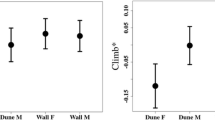Summary
We studied sympatric lynx (Lynx canadensis) and coyotes (Canis latrans) to assess how morphological disadvantages to locomotion over snow affected movement patterns. Both species are of similar size and mass, but the feet of lynx are much larger, and coyotes were found to have 4.1–8.8 times the foot-load (ratio of body mass to foot area) of lynx. This resulted in greater mean sinking depths of coyote limbs, although the magnitude of the difference was less than that in foot-load. Coyotes exhibited stronger use of behavioral patterns that reduced negative effects of snow on movements. Coyotes were most abundant at low elevations where snow was shallow, whereas lynx were mostly at higher elevations. Coyotes also used areas at both elevations where snow was shallower than average, while lynx used areas where snow was deeper. further, both species used travel routes where snow was shallower than it was near the track. Coyotes traveled on harder snow and used trails more frequently, thereby tending to reduce sinking depths to those similar to lynx. The behavioral repertoire of coyotes reduced the morphological advantage of large feet possessed by lynx; however, overall sinking depths were still greater in coyotes. Snowshoe hares (Lepus americanus) were the main prey of both species, and their foot-load was less than that of either predator. Hare kills by coyotes occurred after fewer bounds than did those by lynx, and the large difference between foot-loads of both species of predators may have forced coyotes to ambush rather than chase hares, as did lynx.
Similar content being viewed by others
References
Bakker RT (1983) The deer flees, the wolf pursues: incongruities in predator-prey coevolution. In: Futuyama, DJ, Slatkin M (eds), Coevolution. Sinauer Assoc., MA., pp. 350–382
Formozov AN (1946) Snow cover as an integral factor of the environment and its importance in the ecology of mammals and birds. Materials for fauna and flora of the USSR. Zool. Sect., New Series No. 5. Moscow Society of Naturalists. (Translated by Prychodko, W. and Pruitt, W.O. 1963. Univ. Alberta Boreal Inst. Occas. Pap. No. 1.)
Gier HT (1975) Ecology and behavior of the coyote (Canis latrans). In: Fox, M (ed.), The will canids. R.E. Krieger Publ. Co. Inc., Malabar, Fl. pp. 247–262
Harrison DJ, Bissonette, JA, Sherburne, JA (1989) Spatial relationships between coyotes and red foxes in eastern Maine. J Wildl Manage 53:181–185
Keith LB, Todd AW, Brand CJ, Adamcik RS, Rusch DH (1977) An analysis of predation during a cyclic fluxuation of snowshoe hares. Proc. XIII Int. Cong. Game Biol pp. 151–175
Kelsall JP (1969) Structural adaptations of moose and deer for snow. J Mammal 50:302–310
Kleiman DG, Eisenberg JF (1973) Comparisons of canid and felid social systems from an evolutionary perspective. Anim Behav 21:637–659
Krebs CJ (1989) Ecological Methodology. Harper & Row, New York, NY. 653 pp
Krebs CJ, Gilbert BS, Boutin S, Sinclair ARE, Smith JNM (1986) Population biology of snowshoe hares. I. Demography of food-supplemented populations in the southern Yukon, 1976–84. J Anim Ecol 55:963–982
Kruuk H (1986) Interactions between Felidae and their prey specics: a review. In: Miller SO, Everett DD (eds.), Cats of the world: ecology, conservation, and management. Nat. Wildl. Fed., Washington, D.C., pp. 353–374
Murray DL (1991) Aspects of winter foraging in lynx and coyotes from southwestern Yukon, during an increase in snowshoe hare abundance. M.Sc. thesis, University of Alberta. 155 pp
Nowak RM (1979) North American quaternary Canis. Monograph no. 6, Museum of Nat. Hist., University of Kansas, 154 pp
Parker GR (1981) Winter habitat use and hunting activities of lynx (Lynx canadensis) on Cape Breton Island, Nova Scotia. In: Chapman JA, Pursely D (eds), Proceedings to the worldwide furbearer conference. Frostburg, Md., (1980). pp 221–248
Parker GR, Maxwell JW, Morton LD, Smith GEJ (1983) The ecology of the lynx (Lynx canadensis) on Cape Breton Island. Can J Zool 61:770–786
Quinn NWS, Parker G (1987) Lynx. In: Novak, M, Baker JA, Obbard ME, Malloch B (eds.), Wild furbearer management and conservation in North America. Ont. Min. Nat. Res., Toronto, On., pp. 683–694
Repenning CA (1967) Palearctic-Nearctic mammalian dispersal in the late Cenozoic. In: Hopkins DM (ed.), The Bering land bridge. Stanford Univ. Press, Stanford, Calif. pp. 288–311
Sokal RR, Rohlf FJ (1981) Biometry. W.H. Freeman & Co. New York, NY. 859 pp
Sunquist ME, Sunquist FC (1989) Ecological constraints on predation by large felids. In: Gittleman, J.L. (ed.) carnivore behavior, ecology, and evolution. Cornell Univ. Press, Ithaca, N.Y. pp. 283–301
Telfer ES, Kelsall JP (1979) Studies of morphological parameters affecting ungulate locomotion in snow. Can J Zool 57:2153–2159
Telfer ES, Kelsall JP (1984) Adaptation of some large North American mammals for survival in snow. Ecology 65:1828–1834
Todd AW, Keith LB (1976) Responses of coyotes to winter reductions in agricultural carrion. Alberta wildlife technical bulletin. No. 5. 32 pp
Voigt DR, Earle BD (1983) Avoidance of coyotes by red fox families. J Wildl Manage 53:852–857
Voigt DR, Berg WE (1987) Coyote. In: Novak M, Baker J, Obbard ME, Malloch B (eds.), Wild furbearer management and conservation in North America. Ont. Min. Nat. Res. Toronto, On. pp. 345–356
Author information
Authors and Affiliations
Rights and permissions
About this article
Cite this article
Murray, D.L., Boutin, S. The influence of snow on lynx and coyote movements: does morphology affect behavior?. Oecologia 88, 463–469 (1991). https://doi.org/10.1007/BF00317707
Received:
Accepted:
Issue Date:
DOI: https://doi.org/10.1007/BF00317707




